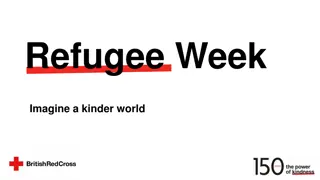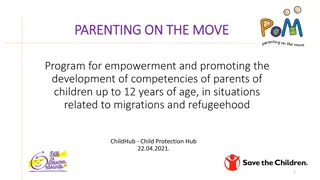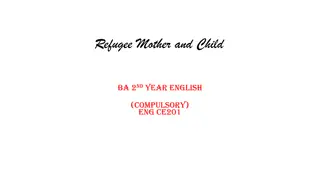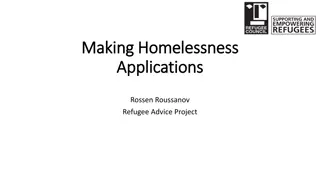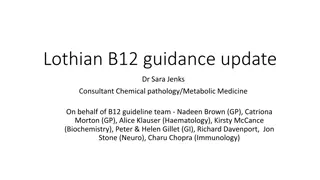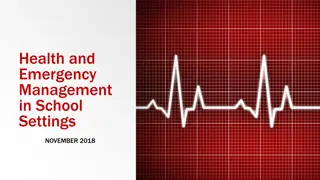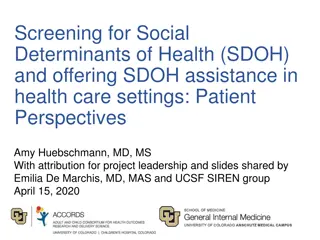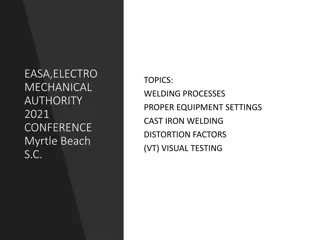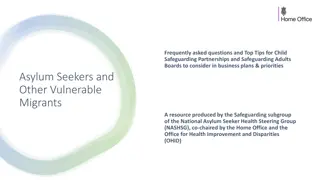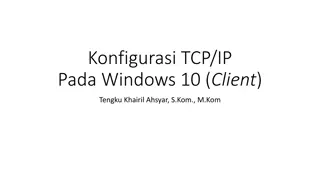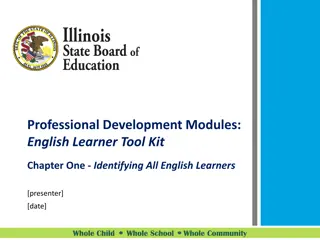Comprehensive Guide to Understanding Anaemia in Refugee Settings
This comprehensive guide provides insights into anaemia, focusing on key terms, generalities, anaemia definition categories, and essential information for data collection in refugee settings. Learn about haemoglobin, iron deficiency, HemoCue, standard procedures, ethical considerations, and more to effectively monitor and address anaemia. Follow standard methods for measuring haemoglobin levels and maintaining quality results using the HemoCue machine. Gain knowledge on anaemia prevalence data collection and definitions for different age and sex groups.
Download Presentation

Please find below an Image/Link to download the presentation.
The content on the website is provided AS IS for your information and personal use only. It may not be sold, licensed, or shared on other websites without obtaining consent from the author. Download presentation by click this link. If you encounter any issues during the download, it is possible that the publisher has removed the file from their server.
E N D
Presentation Transcript
SENS Surveys [Camp/Setting names] Region, Country - Time frame Survey Training [PLACE, DATES] [LOGO PARTNERS]
Session 6: Anaemia Generalities, target group and sampling Material needed Standard procedures Ethical considerations Blood samples and security measures Common errors Demonstrations, practical exercise and standardization exercise
Key Terms Haemoglobin: The oxygen-carrying part of red blood cells. The amount of haemoglobin (Hb) in blood is typically expressed in g/dL (grams of Hb per decilitre of blood). It is also sometimes expressed in g/L (grams of Hb per litre of blood) Anaemia: A condition caused by a reduced Hb concentration in the blood (i.e. decrease in number of red blood cells). This results in reduced oxygen-carrying capacity, and may lead to reduced aerobic activity in the body s cells Iron deficiency: Not enough iron in the body can result in iron deficiency anaemia because iron is necessary to make Hb. Iron deficiency is due to inadequate dietary iron and blood loss. The most common type of anaemia is due to iron deficiency resulting from inadequate iron intake from foods HemoCue: Portable device used to measure Hb concentration in the blood
Key Messages Data on the prevalence of anaemia is essential to collect in refugee settings for monitoring purposes Standard methods should be followed for measuring haemoglobin (Hb) using the HemoCue machine and for standardizing the process maintain the quality, reliability and usability of the results To Definition Anaemia is said to exist when the level of circulating Hb in the patient is lower than that of healthy persons of the same age group and sex in the same environment
Anaemia Definition (Source: WHO 2000) Categories of Anaemia* (Hb g/dL) Age/Sex Groups Total Mild Moderate Severe Children 6-59 months <11.0 10.0-10.9 7.0-9.9 < 7.0 Non-pregnant adult females 15-49 ans ** <12.0 11.0-11.9 8.0-10.9 < 8.0 Pregnant Women*** <11.0 10.0-10.9 7.0-9.9 < 7.0 * These categories are for people living at sea level. At elevations above 1000m, Hb concentrations increase as an adaptive response to the lower partial pressure of oxygen and reduced oxygen saturation of blood. The compensatory increase in red cell production ensures that sufficient oxygen is supplied to tissues. ** This category includes lactating women. *** Anaemia cut-offs for pregnant women should be adjusted depending on the stage of pregnancy. In surveys, gestational age is difficult to ascertain and rarely collected. Because of these difficulties and the small sample size, pregnant women are not included in nutrition surveys for the assessment of anaemia in refugee settings.
Objectives Primary objective o To measure the prevalence of anaemia in children aged 6-59 months and in women of reproductive age between 15-49 years (non-pregnant) Secondary objective oTo determine enrolment into Antenatal Care Clinic (ANC) and coverage of iron-folic acid supplementation in pregnant women
Key Terms Antenatal Care Clinic (ANC): Commonly referred to as ANC. Those clinics provide care and follow-up for pregnant and lactating women Iron-folic acid supplements: Supplements provided to pregnant women. WHO recommends daily oral iron and folic acid supplementation with 30mg to 60mg of elemental iron and 400 g of folic acid for pregnant women to prevent maternal anaemia, puerperal sepsis, low birth weight and preterm birth
Target Group and Sampling To be adapted Example: Children 6-59 months All children in all selected households (Anaemia) Women 15-49 years (NON-PREGNANT) All women every second selected households (including lactating women) (Anaemia) Women 15-49 years (PREGNANT) selected households (including lactating women) (ANC, iron-folic acid supplementation) All pregnant women every second
Material Needed (1/2) HemoCue Hb 301 Analyser and Analyser cases Safety lancets (sizing of at least 2.25 mm) HemoCue Microcuvettes
Material Needed (2/2) HemoCue cleaning spatula Eurotrol Hb 301 Control Solutions (high, low, normal) to verify HemoCue device and microcuvettes quality Alcohol swabs Gloves Tissue paper for wiping blood drop Biohazard waste containers for sharps and contaminated supplies Spare batteries for HemoCue machine Referral forms to refer severely anemic children and women for treatment for cleaning interior of HemoCue machine
Stick a finger (1/6) 1. Explain procedure o Briefly explain the procedure and explain that they may experience a pain from the finger prick Explain that the benefits to participants will be that their anaemia status will be known and that they will be referred to the health clinic if they are found to be severely anemic o If the woman is uncomfortable with the procedure, answer any questions she may have. Ensure that the woman knows that she is free to withdraw from the survey at any time and that nothing bad will happen if she does o
Stick a finger (2/6) 2. Prepare work station o Put a new pair of gloves and layout all the supplies to be used for the measurement on a piece of paper roll o Close the microcuvette container immediately after taking out the microcuvette 3. Ensure correct position of the participant o Face the participant and, if you are right-handed, position yourself to be able to comfortably hold the woman s finger with your left hand while using your right hand to hold the lancet or microcuvette (reverse if you are left-handed) o A young child who is tested should be seated on the mother s or caregiver s lap, and be provided with reassurance and distracted during testing
Stick a finger (3/6) 4. Hold participant s hand o Do not hold the woman s hand so tightly so as to obstruct blood flow 5. Select finger o Choose the participant s middle or ring finger for the finger stick. The selected finger should not be swollen and should be minimally callused o Remove any rings that are on this finger because the ring might interfere with blood flow. Rings on other fingers do not have to be removed unless they are in the way of the measurer 6. Check finger o Feel the woman s fingers for warmth. If the fingers are cold, rub the fingers vigorously. If warm water is available, you can also warm them by washing them in the warm water
Stick a finger (4/6) 7. Massage finger o Hold the participant s finger for the finger stick. Use a rolling motion to gently massage the finger from the top of knuckle towards the fingertip to increase blood flow 8. Disinfect finger o Clean the participant s fingertip with the disinfectant and allow to air dry 9. Hold finger o Hold the participant s finger and apply gentle pressure to firm the skin so that the lancet will go deeper into the finger
Stick a finger (5/6) 10. Place lancet o Hold the lancet between two fingers and rest the thumb on the needle trigger o Place the lancet on the side of the fingertip rather than on the pad of the fingertip (this will especially help in case fingers are heavily callused) 11. Stick finger o Use a rolling motion to massage the participant s finger even more from the top of knuckle towards the fingertip to increase blood flow o Push firmly the lancet against the participant s skin before triggering the needle with your thumb o Dispose of the lancet immediately after use in a biohazard waste container
Stick a finger (6/6) 12. Initiate blood flow o Apply gentle pressure to the wrist, palm and top of knuckle to initiate blood flow o Do not squeeze or rub the tip of the finger because you may dilute the blood drop with interstitial fluid
Fill the microcuvette (1/4) 1. Wipe away 1st and 2nd blood drop o Using a clean tissue paper, wipe away the first two drops of blood o Do not wipe away the drops with alcohol 2. Sample the 3rd drop of blood o The drop of blood should be large enough to fill the microcuvette in one touch 3. Fill microcuvette o Hold the finger in one hand o Touch the tip of the microcuvette into the middle of the blood drop and fill the microcuvette completely with a single drop of blood in one step The microcuvette fills itself by capillary action
Fill the microcuvette (2/4) 4. Inspect microcuvette o Inspect the microcuvette for air bubbles and check if it is completely filled by holding it up to the light o If you see air bubbles or if you see that it is not completely filled, discard the microcuvette o Never refill a partially filled microcuvette with the same drop of blood because the blood may have started to clot and will give an incorrect reading o If a new microcuvette is needed, refill a new microcuvette from a new blood drop from the same finger puncture if feasible. Otherwise, you may have to make a new prick. If you do need to make another prick, you should use another finger
Fill the microcuvette (3/4) 5. Wipe off excess blood o Carefully wipe off any excess blood from the flat sides of the microcuvette with a clean dry tissue paper o Make sure that no blood is sucked out of the microcuvette while wiping it 6. Place microcuvette in holder o Immediately place the filled microcuvette into the microcuvette holder and read the microcuvette within three minutes of sampling 7. Slide holder o Gently slide the microcuvette holder into the machine until the stop point is reached o Do not slam the holder into position for reading; this may spray blood droplets, which negatively affects the reading
Fill the microcuvette (4/4) 8. Apply a cotton ball o While the HemoCue machine is reading the sample, apply a cotton ball to the puncture wound on the participant s finger 9. Record reading o After a few seconds, the Hb value will appear on the display Record this value 10. Dispose of the microcuvette o Dispose of the microcuvette immediately in the biohazard waste container after reading it
Referral Form (1/2) Obtain the consent from the head of household and/or caretaker of children under 5 years of age and women before to start All children and women with signs of severe anaemia will be given a referral form to go to the nearest health facility: o Child Hb<7.0 g/dL o Woman Hb<8.0 g/dL Referral form 2 copies o Team copy (for Supervisor/Survey manager) o Caregiver/Mother copy
BLOOD SAMPLES AND SECURITY MEASURES
Blood Sample All blood samples and contaminated supplies should be handled with extreme care! Blood is a potential source of infection with HIV, Hepatitis B and C Virus and other blood-borne pathogens
Checklist (1/3) To protect themselves and the survey population from exposure to blood Wash your hands o Always wash hands with soap and water at the start and end of the workday (or before and after each break) Cover your cuts o Cover all cuts with bandages to prevent any possibility of blood from survey population coming into contact with any cuts Avoid penetrating injuries ! oAlthough gloves can prevent blood contamination, they cannot prevent penetrating injuries caused by the instruments used for finger sticks
Checklist (2/3) Wear gloves o Always wear well-fitting disposable latex gloves when sampling blood to protect against exposure to blood. Gloves must be worn during Hb measurement until all specimens and materials are disposed of o Gloves must be disposed of as bio hazardous waste. Gloves must be never reused! o Use new pairs of gloves for each participant Clean up blood spills oImmediately clean up any blood spills with an antiseptic so that survey workers and women do not touch any blood
Checklist (3/3) Disposal in biohazard waste oAll materials coming in contact with blood must be placed in bio hazardous waste containers after use and disposed of according to standards. Immediately dispose of any tissue paper, gloves, used lancets, microcuvettes and other supplies that have been in contact with blood in the biohazard waste container If an accident occurs oAny skin surfaces or mucous membranes that come in contact with blood must be immediately and thoroughly washed with a large amount of water and soap o The supervisor is to be contacted immediately
Common Errors (1/6) Common error Improperly stored microcuvettes Description Improperly stored microcuvettes should not be used for testing. Microcuvettes should not be kept in unsealed containers for longer than 3 months. Solution The containers must be kept closed when not in use to avoid exposure to moisture. Not setting-up properly Not preparing all needed materials before testing a participant may affect the quality of the reading. Place a microcuvette, cotton ball with antiseptic solution, a tissue paper, and a lancet on a work station ; turn on HemoCue machine; pull out microcuvette holder to locked position so that digital screen is ready; put on latex gloves. Removing microcuvette from container with fingers wet with alcohol This can result in alcohol coming into contact with the microcuvette; thus the selected microcuvette as well as others inside the container can be destroyed. Take the microcuvette out of its container before handling an alcohol swabs.
Common Errors (2/6) Common error Underfilling the microcuvette Description The microcuvette is only partially filled or only the red circle of the microcuvette is filled with blood. Never use an under filled microcuvette and never refill a partially filled microcuvette with same drop of blood because the blood may have started to clot and will give an incorrect reading. Solution Refill a new microcuvette from a new blood drop from the same finger puncture if feasible. Otherwise, you may have to make a new prick. If you do need to make another prick, you should use another finger.
Common Errors (3/6) Common error Mixing alcohol with blood drop Description Not letting finger to dry completely after disinfecting with alcohol will give a faulty reading. Even a trace of alcohol getting into the microcuvette will affect the reading. Solution Allow finger to air dry after wiping with alcohol. Shallow finger puncture A finger puncture that is too shallow because lancet was not properly placed or not enough pressure was placed while releasing the lancet will restrict blood flow. A deep puncture done with a quick stab will result in better blood flow and more rapid completion of the test. Obstructing blood flow Restricting blood flow to the woman s fingertip following the finger stick because the finger is held tightly will affect testing. Release the woman s finger after the stick to allow blood flow; also hold the woman s hand without squeezing and restricting blood flow to the fingertip.
Common Errors (4/6) Common error Milking the finger Description Excessive massaging or squeezing of the finger will cause tissue juice (interstitial fluid) to mix with and dilute the blood. This will result in erroneous test results, particularly in yielding low levels of Hb concentration in the blood. Solution A good finger stick should result in spontaneous blood flow, negating the need to apply pressure to the finger. If stimulating blood flow is needed, apply gentle pressure with your thumb on the opposite side of the participant s finger from the puncture site. Using the wrong drop of blood Not appropriately wiping off the first two drops may result in an unrepresentative blood sample being tested. Firmly wipe off the first two large blood drops. Firm wiping will stimulate blood flow. Discarding the first two large drops will allow flow of a representative blood sample. Air bubbles in microcuvette Holding the microcuvette in inverted position (slit facing down) during filling can lead to air bubbles being trapped resulting in erroneous reading. Hold the microcuvette with the slit facing up and the pointed tip touching the blood drop.
Common Errors (5/6) Common error Topping off the microcuvette Description Topping off a partially filled microcuvette with repeated blood collection will result in erroneous measurement. Red cells of blood introduced later will not be adequately analysed. Solution Allow a large blood drop to form on the woman s finger so that it will completely fill the microcuvette in one motion. Once filled, hold the microcuvette in place for about 2-3 seconds longer to ensure complete filling. Blood on outside of microcuvette Not cleaning off blood on outside of microcuvette before testing can result in erroneously high reading. Wipe off excess blood from sides of microcuvette using a butter knife motion to ensure that blood from inside the microcuvette is not removed.
Common Errors (6/6) Common error Inadequate placement of the microcuvette Description Slamming the microcuvette holder into place can lead to blood drops spattering inside the reading chamber. This action can damage the reader. Solution Push the microcuvette holder gently into position. Clean the microcuvette holder with disinfectant solution, and completely dry before testing. (Clean the interior of the HemoCue machine with a spatula). Not referring the severely anaemic participants according to local treatment standards The participant is diagnosed as severely anemic and the surveyors do not refer the participant according to the local treatment standards when a facility is available. Participants should be referred for treatment if found to be severely anemic according to the local treatment standards and should be given a paper referral slip to take with them to the health facility.
ANY QUESTION? DISCUSSION
THANK YOU FOR LISTENING! [LOGO PARTNERS]



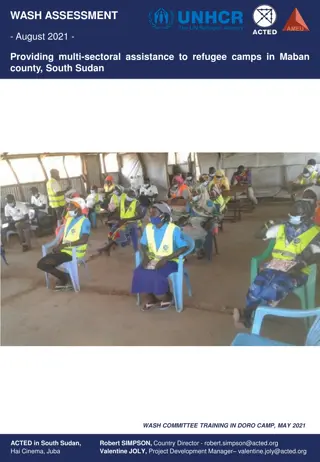


![Enhancing Patient Blood Management in Pregnancy at [INSERT LOCAL HOSPITAL NAME]](/thumb/143207/enhancing-patient-blood-management-in-pregnancy-at-insert-local-hospital-name.jpg)

